UMASH was fortunate to cooperate for a second time with Minnesota Milk Producers (MMPA) at a recent Spanish Dairy Management Workshop. 25 dairy workers
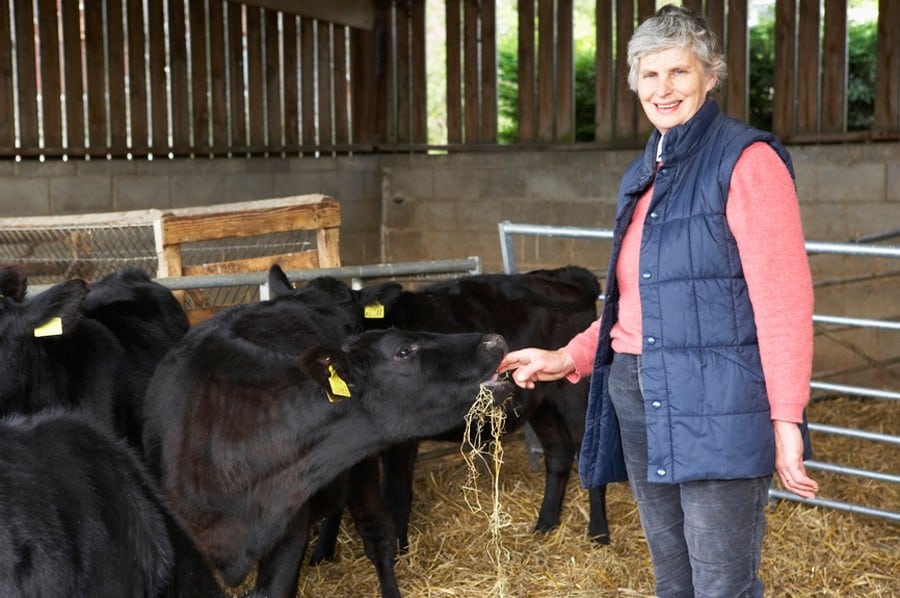
Project Description
Dates: 2011 – 2016
The goal of the UMASH Network Project is to develop a functional, multidisciplinary Network to address occupational health and safety issues among livestock workers.
According to the 2017 CDC report, 416 farmers and farm workers died from a work-related injury, resulting in a fatality rate of 20.4 deaths per 100,000 workers and every day, about 100 agricultural workers suffer a lost-work-time injury. In Minnesota, there were about 2,518 agricultural injuries over the past decade costing some $31.3 million. Hence, having a well-established network has become an important method for interchanging of ideas and sharing of expertise to solve the problems with greater creativity, resourcefulness and speed.
This broad, cross-disciplinary network builds on the group’s skills, experiences, and knowledge in order to translate research, deliver education, and act as a surveillance stream for emerging occupational health and safety concerns in livestock production.
PROJECT GOALS:
- Develop a functional multidisciplinary network of stakeholders that would address occupational health and safety issues among livestock workers.
- Utilize the network as a surveillance mechanism for identifying emerging occupational health and safety issues.
- Provide a platform to integrate knowledge gained from all UMASH projects to create potential solutions to identified health and safety hazards.
Our Project staff has been actively involved in livestock worker health programs. Some highlights include:
- Production and placement of 4 bi-lingual videos (English and Spanish) on needlestick safety on the NIOSH YouTube Channel. These videos have been shared with educators, veterinarians, industry representatives, livestock owners and workers. Videos have been incorporated into some company training programs as well as training for veterinarians.
- Manuscript “Needlestick Injuries in Agriculture Workers and Prevention Programs” accepted for publication in the Journal of Agromedicine.
- In 2015-2016, the team will continue to work on the development of swine and dairy biologics database as a mobile, user friendly tool for rural healthcare providers and poison control staff as a resource for handling potential exposures to various livestock biologics and veterinary drugs. An expert panel will guide content and usability features.
 | 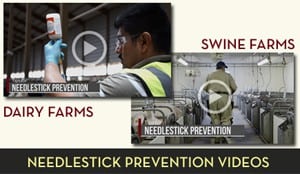 |
The Network project developed educational posters and a fact sheet on dairy stockmanship or low stress animal handling techniques during the fall of 2014 and winter 2015. The team worked in conjunction with dairy specialists and industry representatives. Activities related to stockmanship include:
- Dissemination of posters and fact sheets at Farmfest, National Association of County Agricultural Agents, ISASH, dairy farms, UMASH Annual forum, and on the UMASH website.
- Development of 5 short videos related to dairy stockmanship, to be completed fall 2015. Intended audience is farm workers and students.
- In 2015-16, there are plans to include a dairy stockmanship marketing campaign and program evaluation.
- In 2015 and 2016, the team will continue to work with the National Pork Board to review the impact and use of stockmanship training program developed and distributed by the National Pork Board.
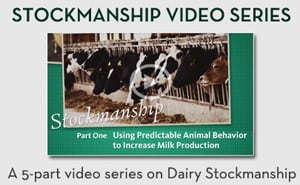 |  |
To better understand the medical and economic impact of livestock associated injuries, the Network team continues to engage the regional insurance industry, the Minnesota Department of Labor and Statistics to characterize the past 10 years of worker’s compensation claims.
- Preliminary findings were shared as a poster at the 2015 National Occupational Research Agenda (NORA) Symposium.
- In 2015-2016, manuscripts are being completed for swine related injuries.
In addition, the UMASH Network team collaborated with AgriSafe Network, the University of Wisconsin-Eau Claire’s College of Nursing and Health Sciences, and the Southern Minnesota Center of Agriculture to host a forum of incorporating health and safety into agricultural curriculum.
- A review of educational programs in the five-state region of Minnesota (MN), Wisconsin (WI), Iowa (IA), North Dakota (ND), and South Dakota (SD) was conducted. Preliminary data from the internet search was shared with participants.
- A summary commentary has been jointly written and submitted for publication.
The Network will allow an interchange of ideas and sharing of expertise to solve problems with greater creativity, resourcefulness and speed.
Project Resources
Project News
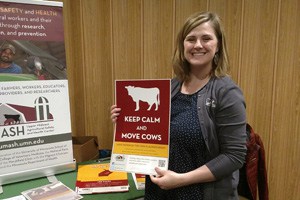

The Cow is Always Right – La Vaca Siempre Tiene La Razon
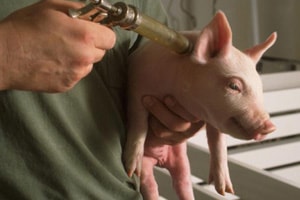


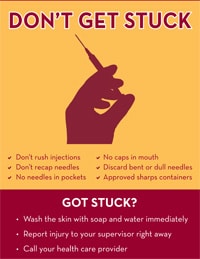
National Hog Farmer Encourages Needlestick Prevention
The National Hog Farmer publication reminded hog producers to use sound practices and protocols when vaccinating or administering medications via sharps.
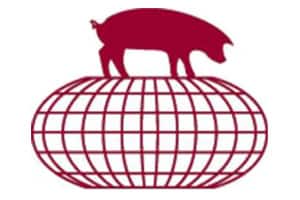
Needlestick Prevention Featured at Leman Conference
The Allen D. Leman Swine Conference is an annual educational event for the global swine industry. It is internationally acclaimed for bringing science-driven
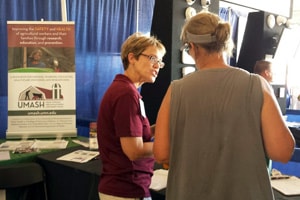
UMASH at Dakotafest 2016 Farm Show
Westward Ho! To farm and ranch country we went to attend the annual Dakotafest farm show in Mitchell, South Dakota. Carol Peterson and Ruth Rasmussen
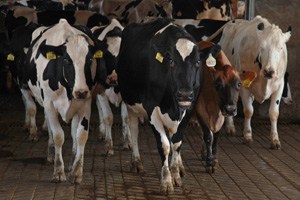
SPOTLIGHT: “Stress Less” with Good Stockmanship and Reduce Worker Injuries
MAY 2016 Jeffrey B. Bender DVM Director/CAHFS, Veterinary Population Medicine, University of Minnesota College of Veterinary Medicine Moving and handling

Jeff Bender Presents Needlestick Prevention Webinar
UMASH Center Co-Director, Dr. Jeff Bender, presented “Don’t Get Stuck! Preventing Needlestick Injuries in Agricultural Settings” as a noontime

UMASH at the Latino Summit
Mankato, Minnesota was the site of the Southern Minnesota Latino Summit on September 10, 2014 attended by four UMASH personnel–Jeff Bender, Carol
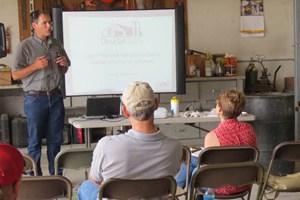
Successful Dairy Systems Field Days With a Focus on Stockmanship Training & Animal Welfare
Three free 4 hour workshops were held in August in Minnesota and Wisconsin focusing on dairy stockmanship. The workshops focused on the interactions between
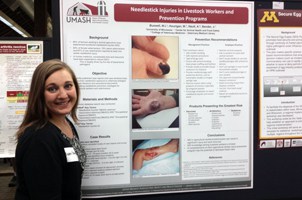
Points of Pride Research Day
The University of Minnesota College of Veterinary Medicine (CVM) held its annual Points of Pride Research Day on October 2, 2013 to celebrate the CVM’s

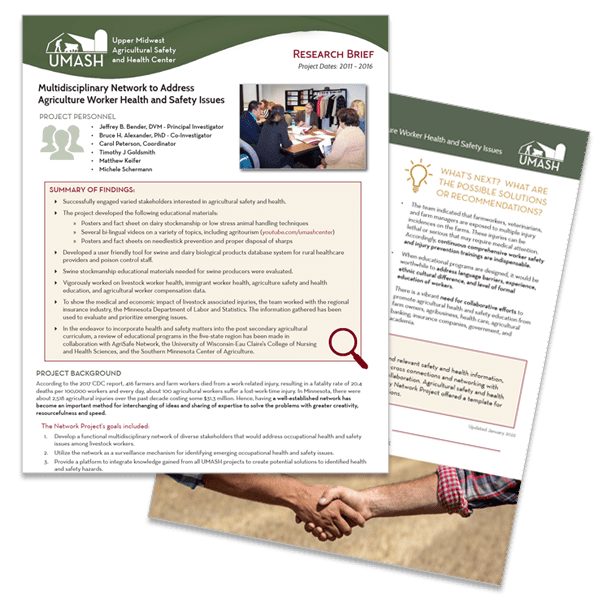


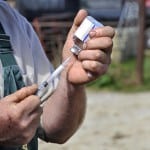 Needlestick injuries in agriculture are common although not as recognized as those in human clinical settings. Farmers, ranchers, veterinarians and on site workers are susceptible to needlesticks on the job. These injuries can be serious and may require medical attention.
Needlestick injuries in agriculture are common although not as recognized as those in human clinical settings. Farmers, ranchers, veterinarians and on site workers are susceptible to needlesticks on the job. These injuries can be serious and may require medical attention.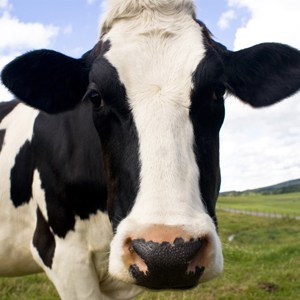 Stockmanship uses our knowledge of the behavior of cows to optimize cow flow, wellbeing and production on farm and to reduce the risk for worker injuries. Methods developed to inform and educate dairy farmers include short video clips, posters and on farm demonstrations. Current and ongoing research has reviewed the perceptions of human-animal interactions and how stockmanship can be used a training tool to benefit both the dairy worker, cows and overall operation.
Stockmanship uses our knowledge of the behavior of cows to optimize cow flow, wellbeing and production on farm and to reduce the risk for worker injuries. Methods developed to inform and educate dairy farmers include short video clips, posters and on farm demonstrations. Current and ongoing research has reviewed the perceptions of human-animal interactions and how stockmanship can be used a training tool to benefit both the dairy worker, cows and overall operation.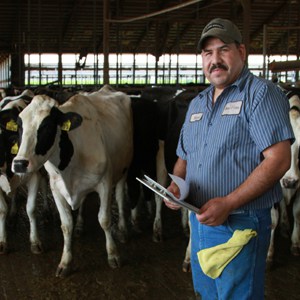 Not much is known about the level of safety training and the extent of injuries that occur on Minnesota and Wisconsin dairy farms. The purpose of this study was to survey dairy workers regarding their training, experience, and history of recent injuries. Conclusions of the study:
Not much is known about the level of safety training and the extent of injuries that occur on Minnesota and Wisconsin dairy farms. The purpose of this study was to survey dairy workers regarding their training, experience, and history of recent injuries. Conclusions of the study: